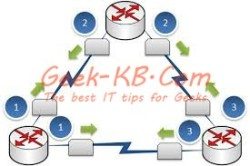In this article, How To set a static route in CentOS/RHEL 6.x I will explain when it is necessary to use a static route and how to set it up. Static routing is a type of method of network routing. Static routing in not actually a routing protocol a manual configuration on the network route. […]
You are browsing archives for
Category: Linux
Most useful Linux tips and tried and tested manuals with screen shots from the Geek-KB
Linux Memory and Process monitoring tool...
This article is part 1 in a series of 3 articles regarding 18 Linux system monitoring tools you should know.
In this article we’re going to cover some built-in system monitoring tools as well as some open source add-on tools
which will make your life easier when troubleshooting issues regarding Memory and Processes in your server.
Most Linux distributions are equipped with many monitoring tools.
These monitoring tools provide metrics which can be used to get information about system activities, such as Disk (storage) usage, CPU and memory, or Network bottlenecks.
You can use the monitoring tools to find the possible causes of a performance issue.
The commands discussed in this article are some of the most basic monitoring commands when it comes to
system analysis and debugging server issues such as:
Finding out bottlenecks.
Disk (storage) bottlenecks.
CPU and memory bottlenecks.
Network bottlenecks.
Setup Open Source Pure-FTPd with MySQL o...
Pure-FTPd is a free and secure FTP server. It provides efficiency and ease of use, simple answers to common needs, plus unique useful features for personal users as well as hosting providers. This how to guide will help you to setup Pure-FTPd with MySQL as user database. Also providing detailed instruction to create a user […]
How To: Upgrade CentOS Linux v6.x to v6....
[hana-code-insert name=’468×15′ /] usage: CentOS Linux v6.5 has been released recently and it is available via repositories for immediate update. The new CentOS versions includes several hundred bug fixes for, and enhancements to the Linux kernel. If you would like to know how to Upgrade CentOS Linux v6.x to v6.5, then keep reading. [hana-code-insert name=’468×15′ /] […]
SSH command line tool How To
Opening a SSH session to a remote machine
The SSH command line to open a session to a remote machine is called ssh.
The syntax is:
ssh remote_machine_ip/hostname
In this case, you will open a SSH session using your currently logged in user as a user for the remote machine,
the SSH command will interpret the command to:
ssh your_current_logged_in_user@hostname
Example:
[root@geek-kb ~]# whoami
How To: Install phpMyAdmin on CentOS/RHE...
In this article I will guide you through the steps to install phpMyAdmin. Some info from wikipedia: PHPMyAdmin is a free and open source tool written in PHP intended to handle the administration of MySQL with the use of a web browser. It can perform various tasks such as creating, modifying or deleting databases,tables, fields or rows; executing SQL statements; or managing users and permissions in a GUI based […]
How To: Set up Apache Virtual Hosts
In this article I will teach you the options available to create Apache Virtual Hosts in order to serve more than one site on the same machine. These scenarios are those involving multiple web sites running on a single server, via name-based or IP-based virtual hosts. Some info from wikipedia: Virtual hosting is a method for hosting multiple domain names (with separate […]







